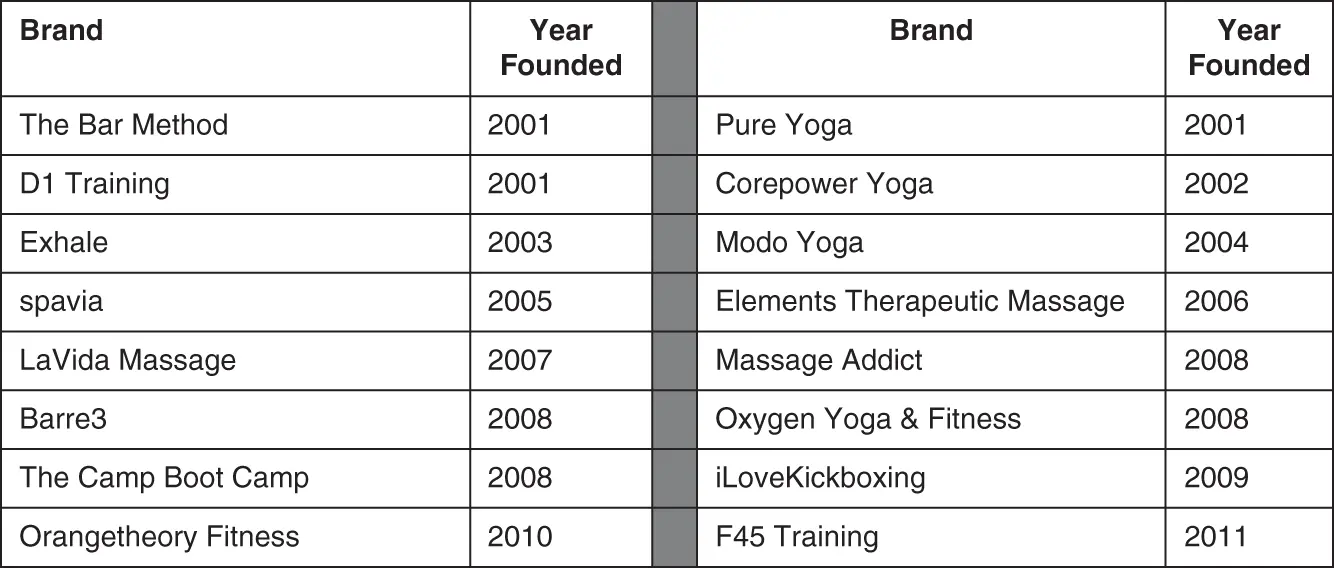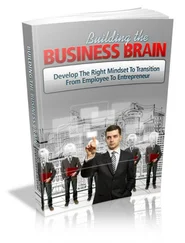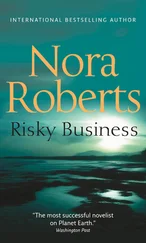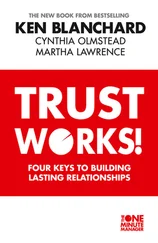In each of these crises, millions more people faced with increased stress and reduced household incomes de-prioritized big-ticket purchases and prioritized self-care, social connections, and affordable luxuries. Crises fueled more demand for wellness services.
Meanwhile, on the business side, corporate layoffs caused tens of thousands of new wellness entrepreneurs to enter the market with new businesses. At Mindbody, we called these people the “Corporate Refugees,” and their energy, resources, and business acumen vastly increased the supply of high-quality local wellness experiences. Several of the boutique brands launched by corporate refugees would go on to become some of the most successful wellness brands we know today (see Figure 3.1).
As these well-known brands prove, crises present opportunities, and you don't have to wait for good times to launch a successful business. In fact, times of recession and strife are the best times to launch an innovative brand.
The Second Wave of wellness firmly established the boutique wellness movement, greatly expanding the size, diversity, and positive impact of the industry. That set the stage for a third and even larger wave of wellness, fueled by the proliferation of smartphones and other connected devices, and the emergence of the largest wellness-oriented generation yet.

Figure 3.1 Examples of Successful Wellness Brands, 2001–2010
The Third Wave of Wellness (2011–2020): Millennials, Smartphones, and Cloud Technology
In the early 2010s, as large numbers of 20- and 30-something Millennials began to enter the workforce, they adopted boutique wellness practices more rapidly and in greater numbers than Gen-Xers and Boomers. As the older generations were still fully engaged, this Third Wave was almost completely additive to the industry.
Millennials are more globally connected and massive in numbers than any previous generation. Coming of age concurrently with the emergence of global high-speed Internet, cloud computing, and powerful smartphones, the Millennial generation is the first to truly think globally. You can speak with tech Millennials in India, China, Japan, and the other developed countries of Asia-Pacific, Europe, and Latin America, and you will find they have more in common with each other than they do with the older generations in their own countries.
Millennials prioritize experiences and social connections over material possessions. They experienced 9/11 as children and the Great Recession as young adults. They grew up with the War on Terror and saw their parents' nest eggs decimated by the real estate crash in 2008–2009. They also attended college in greater numbers and took on more student debt than any previous generation. Many of them struggled to launch their careers during the slow economic recovery of the early 2010s. These formative experiences shaped the Millennial mind, giving them a strong aversion to financial risk and big-ticket purchases. There are plenty of Millennial entrepreneurs, particularly in technology, but as a percentage of their total numbers, this generation has started far fewer businesses than Gen-X-ers or Baby Boomers. This may change in the decade ahead, but so far the classic Millennial would much rather spend discretionary income on low-budget travel and regular boutique wellness experiences than take on debt to buy a home or launch a business.
Millennials also have a strong affinity for globalism, environmental causes, and social justice. Millennials are deeply concerned about climate change and economic inequality. This is the generation that fueled Senator Bernie Sanders's presidential bids, propelled the legalization of gay marriage, and expanded the movement to recognize broad-based LGBTQ+ rights.
Millennials love variety and authenticity. They have an affinity for local and authentic crafts, foods, and experiences. In short, more Millennials align with the principles and ethos of the wellness movement than Baby Boomers and Gen-X-ers combined.
In the 2010s the wellness industry began to morph to meet Millennial tastes. The decade saw the emergence of whole new categories of boutique wellness classes and services, including BootCamp-style workouts and High Intensity Interval Training (HIIT), along with a resurgence of indoor cycling, led by Soul Cycle, FlyWheel, Rush Cycle, Cyclebar, and others. The three largest boutique fitness brands—Crossfit ®, Orangetheory Fitness, and F45 Training—took off in the 2010s, fueled largely by Millennial passion for the tribe-like atmosphere they provide.
Meanwhile, whole new categories of wellness businesses emerged, offering specialized services such as salt room therapies, meditation classes, cryotherapy, intravenous hydration therapy, and boutique beauty and grooming. We can thank Millennials for the cool new hipster barbershops that specialized in classic men's coifs, straight razor shaves, and epic beards, as well as for the proliferation of blow dry bars, nail salons, and lash bars.
All of this differentiation and growth was enabled by iPhones and Android smartphones, unlimited data plans, and the emergence of cloud-enabled technologies.
Yelp went public in 2009 and rapidly expanded the inventory of wellness business reviews in the 2010s. ClassPass and the Mindbody app were both released in 2013, enabling aggregate searching and booking of wellness classes and appointments, and Google released Reserve with Google in 2016, enabling seamless search, discovery, and booking of wellness classes and appointments. In 2017, both Mindbody and ClassPass released dynamic pricing to the wellness businesses they serve, enabling pricing to discount or surge according to local supply and demand.
At the same time, the ability to connect heart rate monitors and exercise machine outputs enabled boutique fitness studios to offer a new form of immersive experience. Innovators such as Fitmetrix, which was founded in 2013 and acquired by Mindbody in 2018, leveraged cloud technologies to greatly reduce the cost of deploying these capabilities in studios. At the same time, innovators such as Peloton ®, founded in 2012, and Mirror ®, founded in 2016, leveraged the same equipment and cloud technologies to bring connected fitness and group exercise into people's homes.
Collectively, these technological advancements helped to further expand, globalize, and democratize the Third Wave of wellness. By the end of the decade, one could just as easily find a boutique wellness studio in Prague, Bangalore, and Shanghai as they could in Los Angeles, New York, London, or Sydney. And, when someone walked into that studio, they would most likely encounter clientele representing all three postwar generations. Wellness had indeed gone mainstream and global, and was worth more than $4.5 trillion in 2019.
And then COVID-19 hit.
4 The Future of Wellness in a Post-COVID World
COVID-19 interrupted the Third Wave of wellness. Without a global disaster of this magnitude, the Third Wave would have continued deep into the 2020s, fueled by ever greater numbers of Millennials entering their peak spending years and the continued strong engagement of Gen-Xers and aging Baby Boomers.
Virtual wellness offerings would have expanded and improved gradually throughout the decade with superior accessibility and affordability. Larger and better on-demand and live-streaming content combined with ever-improving and less expensive connected devices would have further expanded and democratized the overall wellness market. This would have siphoned only a portion of the growth that might otherwise have gone to face-to-face experiences at the brick-and-mortar studios.
Читать дальше













